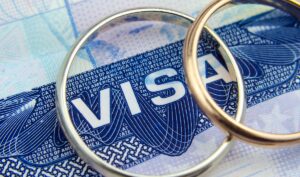
For couples starting their life together in the United States, the journey from a K-1 fiancé(e) visa to a green card can be both exciting and complex. If you’re a K-1 entrant planning to adjust status, knowing what to expect and understanding the steps involved can help reduce stress and lead to a smoother, more successful experience. This guide will walk you through the adjustment of status process, share insights on common challenges, and offer actionable tips to help you on the path to permanent residency.
Why K-1 Visa Holders Need to Adjust Status
Eligibility for Adjustment of Status through a K-1 Visa
How to Adjust Status form K-1 to Permanent Resident
Understanding the Adjustment of Status Timeline and Potential Delays
Common Mistakes and How to Avoid Them
How CitizenPath Can Help You with Adjustment of Status
Why K-1 Visa Holders Need to Adjust Status
The adjustment of status process allows K-1 visa holders, who have recently married their U.S. citizen fiancé(e), to apply for a green card (permanent residency) without leaving the United States. Since the K-1 visa is designed specifically for this purpose, K-1 entrants are usually well-positioned for the adjustment process, but there are specific steps and requirements to follow.
The K-1 visa is valid for only 90 days after entry. If the beneficiary plans to stay in the United States, adjustment of status to green card is generally how the couple must proceed.
Eligibility for Adjustment of Status through a K-1 Visa
To be eligible for adjustment of status, K-1 visa holders must:
- Have entered the U.S. with a valid K-1 visa;
- Married their U.S. citizen petitioner within 90 days of entering the U.S.; and
- Meet the general requirements for adjustment of status.
If you’re a K-1 visa holder who married within the required timeframe, you’re in a good position to apply for a green card. The steps below will guide you through the process, including necessary forms, documentation, and practical advice for a smoother application.
How to Adjust Status form K-1 to Permanent Resident
The journey from K-1 visa holder to permanent resident requires a series of important steps to successfully apply for your green card. This section provides a clear, step-by-step guide to help you navigate the adjustment of status process confidently and avoid common pitfalls along the way.
Get Medical Exam and Vaccinations if Necessary
As an applicant for adjustment of status through a K-1 visa, you generally do not need to repeat the immigration medical examination. K-1 entrants typically complete a medical exam as part of the consular processing.
If you had a medical exam abroad before entering the U.S. on a K-1 visa, you might be able to skip a new medical exam, as long as:
- You file Form I-485 within one year of your overseas medical examination; and
- The medical examination did not reveal a Class A medical condition.
However, some K-1 visa holders may need to update their vaccinations to meet U.S. requirements, which can be done without a full medical exam. Check your initial exam results and vaccination record, and consult the USCIS guidelines for vaccinations to confirm what’s required in your case. If you need an updated exam or vaccinations, try to schedule them as soon as possible to avoid processing delays.
Prepare Your Adjustment of Status Forms
When applying to adjustment status through a K-1 entry, you'll generally need to file a few forms concurrently.
- Form I-485, Application to Adjust Status
The primary form in an adjustment of status package is Form I-485. This is the application for permanent residence (green card). Entering as a K-1 fiancé and subsequently marrying the U.S. citizen who sponsored the visa is a basis for eligibility. - Form I-864, Affidavit of Support
The U.S. citizen sponsor must prepare Form I-864 to show that the K-1 spouse has adequate means of financial support and is not likely to become a public charge. Generally, this means that the sponsor must have an income greater than 125% of the poverty guidelines. However, there are other ways to satisfy this requirement. - Form I-131, Application for Travel Document (optional)
Use this form to request an advance parole travel document. The adjustment of status process typically takes several months. If the beneficiary should need to travel abroad during this time, they must obtain an advance parole document to preserve the application and reenter the U.S. USCIS will likely consider an I-485 application abandoned if the applicant departs the U.S. without advance parole. - Form I-765, Application for Employment Authorization (optional)
Use this form to request employment authorization. As mentioned, the adjustment of status process typically takes several months. During this time, the applicant requires employment authorization if they will work in the United States.
Many people can file an adjustment of status on their own, but the process can be complex and time-consuming. CitizenPath was created by immigration attorneys to support do-it-yourself filers. Our affordable platform helps you avoid common mistakes, ensuring your USCIS form is prepared correctly. After completing your form on CitizenPath, you’ll receive a ready-to-print USCIS form and customized filing instructions outlining the exact documents you need. Learn More >
Gather Supporting Documents
When adjusting status through a K-1 visa, gathering the right supporting documents is essential for a smooth application process. USCIS requires various documents to verify your eligibility and support your application. These documents include your marriage certificate, your I-129F petition approval, I-94 arrival/deparature record, as well as the many documents necessary to evidence a viable financial sponsor.
Being organized and thorough in this step can help prevent delays. Missing or incomplete documentation is one of the most common reasons for requests for additional evidence (RFEs), which can significantly extend your processing time. When using CitizenPath to prepare your forms, you also receive a customized checklist of required documents. Review each item carefully and ask our team questions if you need help. By taking extra care to gather all necessary materials upfront, you’ll strengthen your application and improve your chances of a quick, successful adjustment of status.
We always recommend that our customers make a photocopy of everything for their records. Consider including a cover letter that lists all documents and forms in the packet. This organization helps the USCIS officer reviewing your application and can speed up processing.
Understanding the Adjustment of Status Timeline and Potential Delays
The adjustment of status process for K-1 visa holders can vary in length, depending on factors such as USCIS office location and individual case complexity.
Form I-485 Processing
The Form I-485 processing time can vary widely depending on factors like USCIS workload, location, and individual case details. Most people can expect processing to take between 8 to 14 months. After submitting Form I-485, USCIS will schedule a biometrics appointment and, later, an in-person interview to verify your eligibility. During this period, you can track your case status online using your USCIS receipt number. Preparing your application accurately can help minimize delays in this timeline.
Biometrics Appointment
Typically a few weeks after filing the adjustment of status package, USCIS will mail you an appointment notice for a biometric screening. The biometrics appointment is a short appointment at a USCIS Application Support Center for the purpose of collecting fingerprints, photographs and other data. They’ll use this information to perform a background check and create the green card.
Adjustment of Status Interview
Adjustment of status through a K-1 visa entry will always include an interview. Applications for permanent residents via marriage are some of the most abused by individuals seeking to circumvent immigration laws. Therefore, you should expect some additional scrutiny with your application.
If you have married for genuine reasons (and not for the primary purpose of obtaining a green card), there’s nothing to worry about. You and your spouse won’t have any problem answering questions asked by the USCIS officer. None the less, it’s best to prepare for the I-485 interview.
Common Mistakes and How to Avoid Them
Even small mistakes can delay the adjustment of status process. Here are some common pitfalls for K-1 entrants and how to avoid them:
- Incomplete Documentation: Make sure all required documents are included and organized. Missing items can trigger delays and requests for evidence.
- Incorrect Filing Fees: Double-check current fees for Form I-485 and other required forms. Incorrect fees can result in application rejection.
- Unreported Changes of Address: If you move during the adjustment process, report your new address to USCIS within 10 days to ensure you receive all notices.
Review your packet carefully before sending it and stay on top of deadlines to reduce the risk of errors.
How CitizenPath Helps You with Adjustment of Status through a K-1 Entry
Navigating the adjustment of status process as a K-1 entrant can be daunting, especially if you’re trying to handle it independently. CitizenPath is here to help. We provide affordable, easy-to-understand immigration services, designed specifically to empower immigrants and their families.
Our platform guides you step-by-step through form preparation, offers alerts to help avoid common mistakes, and ensures you’re ready for every step in the adjustment of status process. CitizenPath helps you get a green card or you pay nothing. We provide support for the Adjustment of Status Package (Form I-485), Affidavit of Support Package (Form I-864), and several other immigration services.
We also invite you to sign up for our newsletter for regular tips and insights, keeping you informed and empowered throughout your journey.
Want more immigration tips and how-to information for your family?
Sign up for CitizenPath’s FREE immigration newsletter and
SAVE 10%
on our immigration services






